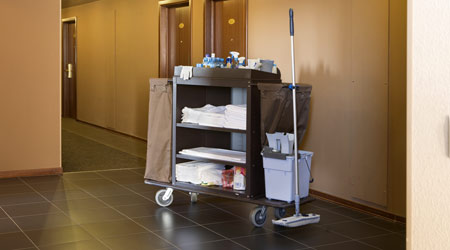
The custodial cart can be an effective tool in cleaning or it can be a disaster. I have encountered carts that looked more like food stands due to the personal items and disorganization.
One cart was full of various chemical containers (unnumbered and some unlabeled), three bowl swabs, two dusters, a quart of 26 percent bowl acid cleaners, a buffing pad, multiple soiled rags, two rolls of toilet tissue that had evidence of water damage, four soap cartridges AND two hot dogs, a soda, chips, makeup kit and a purse. When I mentioned this to the supervisor, he responded that each worker had the right to customize their cart as they saw fit so long as they got the job done.
My first challenge was to educate the supervisor on the value of having a clean, well-organized cart that enabled the worker to be productive while also being safe. Food and personal items should not be allowed on a cart at any time. Failing to maintain the cart with only the necessary products to be used that shift was simply not following custodial best practices. Following is a suggested list for a typical custodial cart that would be used in zone cleaning. Note that this list will vary based on differing requirements at different sites so adjust as necessary.
• Full containers for glass, all purpose, disinfectant, bowl cleaner (rest rooms), polish (optional) that are color coded and numbered.
• Optional products include mild, buffered acid cleaners for mineral deposits, deodorizers and mild, abrasive cleansers for occasional use.
• Products NOT to include: bleach, pine scent, ammonia, bowl acids or anything not needed.
• Cleaning cloths (can be disposable wipes, microfiber, cotton or a combination) that are clean. There should be enough to complete the shift without cross-contamination.
• A clean lambs wool duster with an extension so that vents can be reached.
• Sufficient rolls of toilet tissue, paper towels, hand soap, sanitary liners and any other replaceable products.
• A clean, double bucket and wringer combination with microfiber mop heads that can be replaced after a predetermined number of uses.
• A plastic, angle broom and dust pan. Both of which should be cleaned regularly.
• Optional: note pad/pencil, inspection mirror and other similar tools
• Can you think of anything else?
Your comments and questions are important. I hope to hear from you soon. Until then, keep it clean...
Mickey Crowe has been involved in the industry for over 35 years. He is a trainer, speaker and consultant. You can reach Mickey at 678-314-2171 or CTCG50@comcast.net
posted on 8/29/2016

 The Down and Dirty on Cleaning in Virus Season
The Down and Dirty on Cleaning in Virus Season How Surfactant Use is Expanding in Commercial Cleaning
How Surfactant Use is Expanding in Commercial Cleaning Operational Excellence Series 2025: Better Budgeting
Operational Excellence Series 2025: Better Budgeting
